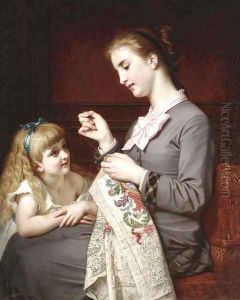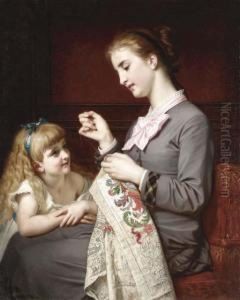Hughes Merles Paintings
Hughes Merle was a French painter who was born on March 1, 1823, in Saint Marcellin, France. He is known for his works that often depicted sentimental or moral subjects, and his style is characterized by a fine, detailed technique that reflects the influence of the academic art tradition of the 19th century.
Merle studied painting in Lyon before moving to Paris, where he became a student of the famed academic painter Léon Cogniet. Under Cogniet's guidance, Merle developed his skills and was exposed to the Parisian art scene, which at the time was a melting pot of different artistic movements, including Romanticism and the emerging Realism.
Despite the changing artistic trends of his time, Merle maintained a focus on traditional subjects and storytelling through his art. He often portrayed scenes from history, literature, and mythology, as well as intimate genre scenes that featured emotional and moral themes. His work is noted for its clarity, precision, and the use of light to evoke mood and character.
Hughes Merle achieved success and recognition in the French art world during his lifetime. He exhibited regularly at the Paris Salon, the official art exhibition of the Académie des Beaux-Arts, and received several medals for his work.
Throughout his career, Merle's paintings were widely appreciated for their narrative quality and technical virtuosity. Some of his notable works include 'The Virgin, the Baby Jesus and Saint John,' 'Ophelia,' and 'The Pardon of Assisi,' which demonstrate his ability to capture both the tenderness of religious scenes and the psychological depth of characters from literature.
Hughes Merle passed away on May 5, 1881, in Paris. While he may not be as well-known today as some of his contemporaries, his contributions to 19th-century French painting continue to be recognized by art historians and collectors. His works can be found in museums and private collections around the world, serving as a testament to his skill and the enduring appeal of academic art.

